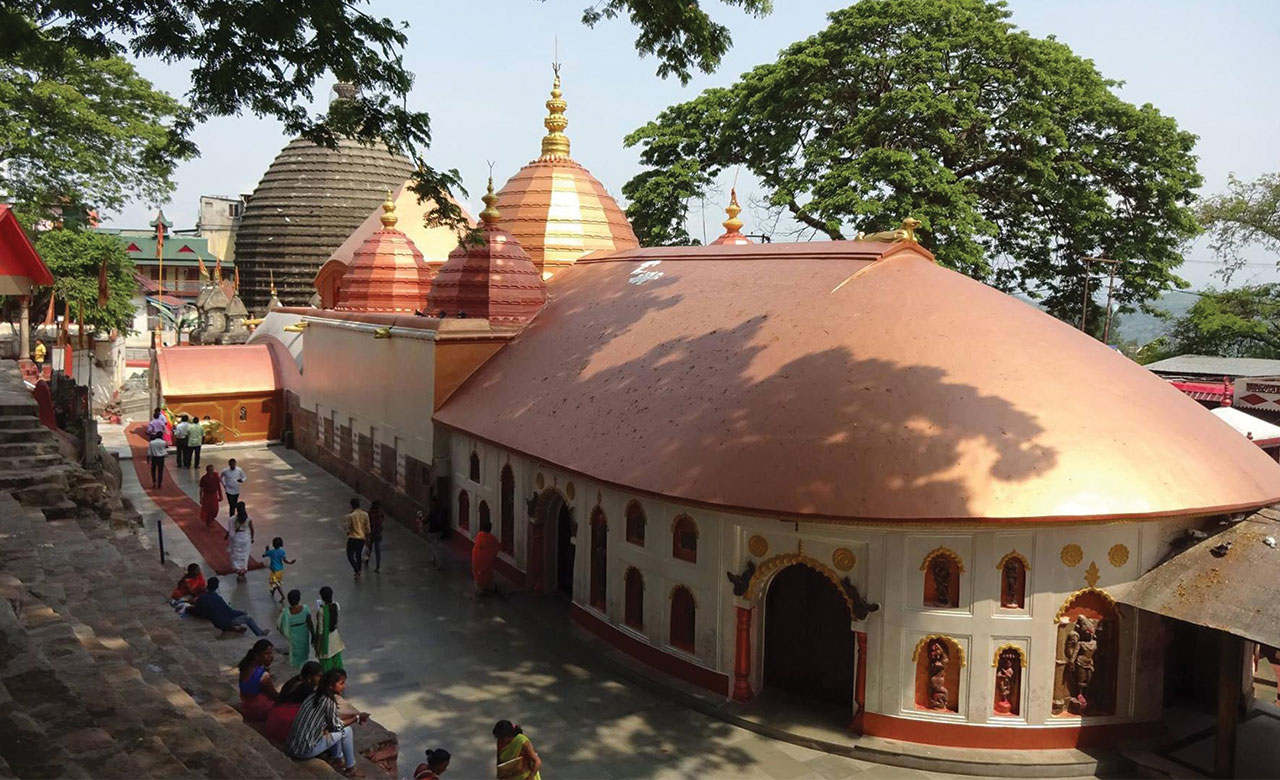
Spirituality
Most powerful tantric temples of India Series Part 2- Kamakhya temple
A bleeding Goddess, a temple where humans are sacrificed, a place run over by black magic, a temple of menstruation, a place where Tantric and Aghoris perform their horrific rituals. Many urban legends portray Kamakhya Temple as a place engulfed in mysticism. Almost all of them are having some element of truth, and mostly the twisted truth.
One of the oldest among 51 Shakti Peethas, Kamakhya temple is situated on the top of Nilachal Hill, on the western side of Guwahati, Assam. There are ten small temples, dedicated to the Goddesses of Das Mahavidyas. Among those, Mother Goddess Kaali, Tara, Sodashi, Bhuvaneshwari, Bhairavi, Chhinnamasta, Dhumavati, Bagalamukhi, Matangi, and Kamalatmika have separate small shrines. In the central shrine, you will find the abode of Tripurasundari, Matangi and Kamala.
The main temple is dedicated to Mother Goddess Kamakhya. Temple has one Garbhagriha and three Mandapas. Unlike the traditional temples, Garbhagriha or Sanctum Sanctorum of the temple is a cave.
Like any other cave, this sanctum is narrow and dark. In the cave, you cannot find an idol of Goddess Kamakhya. Instead, you will find an interesting monolith folding of a stone, making a shape like 10 inches deep Yoni. This vulva-shaped formation is worshiped as the goddess Kamakhya herself. Underground spring fills this formation with water.
It is considered as the temple land was the ancient sacrificial site for the tribal goddess, Kameikha. Temple is considered to be constructed in the 8th century by the Kings of Kamata Kingdom. Post that, the temple was destroyed by Kalapahar in the 15th century. Ahom King Rudra Singha (reign 1696 to 1714) reconstructed the temple as we see today.
The Ambubachi Mela:
In the middle of June, when the sun enters the zodiac Mithun, a grand celebration takes place. The temple is shut down for three days during the rainy season and the yearly Mela festival is celebrated attracting hundreds of thousands of devotees from all over India. It is believed that Mother Goddess Kamakhya undergoes her annual menstruation cycle in these three days, keeping the temple doors locked. After three days and after the bath and a few other rituals, temple doors are again opened for devotees. It’s said that during these three days, the river Brahmaputra, flowing around the mountain mysteriously turns red during the Mela, and becomes transparent after the celebrations are over, signifying menstruation.
The Legend:
You will find the legend, attached to this temple very interesting.
Once, King Daksha decided to have a Yadnya. He invited everyone to accept her Daughter Sati and his son in law Shiva. Even though not invited, the couple reached the venue anyway, only to get insulted by the King. Not able to bear the insult of her husband, Sati dove in the fire of Yandya, burning and killing herself. Traumatized Shiva, in deep agony, took her body on his broad shoulders and started Tandava, the fierce celestial dance.
Seeing the whole universe is in Danger, preserver Lord Vishnu cut Sati’s body in 51 pieces with his Sudarshan disc, in order to stop Shiva’s calamitous Tandav. These 51 pieces fell on the land, today known to be Shakti Peethas of the Mother Goddess. It is to be believed that Sati’s womb with her Vulva fell down on a hill, today known to be Kamakhya temple.
Kamakhya is the ultimate symbol of fertility, a sign of nature being ready to be a mother nature in a literal sense. Combination of Shiv and Shakti results in the manifestation of the world. In ancient India, menstruation was considered a sacred thing. A unique ability, only gifted to a woman by nature to procreate. Mother Kamakhya symbolizes the power of celestial regeneration.
Mother Goddess Kamakhya is also known as Siddha Kubjika, a Tantric Goddess, living in Himalaya. Often, Maa Tripura Sundari is prayed here, in the form of Sri Yantra. Kamakhya prayed here in the form of Prakriti, or nature, abiding the natural laws. It is said that the Vermillion from the Puja performed at this temple has a potency to ward of black magic, evil eye, witchcraft, and other evil energies from you.
-A very specific Tantra Puja has performed year round, in order to get freedom from the obstacles in the path of life.
-It is believed that Mother Goddess Kamakhya bestows grace on your progress in business or in one’s professional life, apart from gaining monetary benefits such as health, wealth, and other materialistic possessions.
-These days, Kamakhya is known to restore a balance in relationships, especially she is popular among the couples who are going through marital problems.
-Couples visit Mother Goddess, for building harmonious and everlasting relationships with each other.
-Often childless couples visit Mother Goddess Kamakhya to conceive.
-Parents bring their daughters when they reach womanhood here, to get the blessing and celebrate the Power of the feminine. During these rituals, the new woman learns about hygiene to be maintained during menstruation.
We live in such a modern age, where the word breast is banned on television. We live in a progressive world where if a lady wants to buy a menstrual pad, she has to do that in a hushed voice. Then, coated in a black polythene bag, or wrapped tightly in a brown bag, the shopkeeper hands over these sanitary napkins like a bag of narcotics. Where the word menstruation has engulfed in a thick coat of taboo, thanks to the Tantra sect, the temple celebrating menstruation is a ray of hope. And hence, Mother Goddess Kamakhya, the symbol of the power of procreation and fertility should be preserved and celebrated in large numbers in the mainstream.
Post a Comment
Leave a comment
-
Subscribe to Our Blog
-
Categories
-
Popular Articles
- Dead moth in the house. What universe is trying to tell you?
- Vivah Bandhan Curse – What Is It and How to Spiritually Heal It.
- Tripura Sundari | The Dasa Mahavidya
- What are Beej Mantras?
- The Dasa Mahavidyas
- Ramakrishna Paramhansa – The Man who almost became a Woman
- Maa Bhuvaneshwari | The Dasa Mahavidyas
- How does the Moon Affect Us?
- Maa Chinnamasta | The Dasa Mahavidyas
- Maa Bhairavi | The Dasa Mahavidyas




Excellent post! We are linking to this great content on our site. Keep up the good writing. Ruthy Klement Hubble
Hey, thanks for the blog post. Really thank you! Fantastic. Sheena Bill Siegfried
Thanks to my father who told me on the topic of this webpage, this web site is truly amazing. Shaina Alric Myrna